Comparative Study of Traveling and Standing Wave-Based Locomotion of Legged Bidirectional Miniature Piezoelectric Robots
Abstract
:1. Introduction
2. Design
2.1. TW-Based Locomotion
2.2. SW-Based Locomotion
3. Materials and Methods
4. Results and Discussion
4.1. TW-Based Locomotion Results
4.2. SW-Based Locomotion Results
5. Conclusions
Supplementary Materials
Author Contributions
Funding
Institutional Review Board Statement
Informed Consent Statement
Data Availability Statement
Acknowledgments
Conflicts of Interest
References
- Kim, S.; Clark, J.E.; Cutkosky, M.R. iSprawl: Design and Tuning for High-speed Autonomous Open-loop Running. Int. J. Robot. Res. 2006, 25, 903–912. [Google Scholar] [CrossRef]
- Birkmeyer, P.K.; Peterson, K.; Fearing, R.S. DASH: A dynamic 16 g hexapedal robot. In Proceedings of the IEEE/RSJ International Conference on Intelligent Robots and Systems, St. Louis, MO, USA, 10–15 October 2009. [Google Scholar]
- Haldane, D.W.; Peterson, K.C.; Garcia Bermudez, F.L.; Fearing, R.S. Animal-inspired Design and Aerodynamic Stabilization of a Hexapedal Millirobot. In Proceedings of the IEEE International Conference on Robotics and Automation (ICRA), Karlsruhe, Germany, 6–10 May 2013. [Google Scholar]
- Developing Microrobotics for Disaster Recovery and High-Risk Environments. Available online: https://www.darpa.mil/news-events/2018-07-17 (accessed on 23 December 2020).
- Chen, Y.; Doshi, N.; Wood, R.J. Inverted and inclined climbing using capillary adhesion in a quadrupedal insect-scale robot. IEEE Rob. Autom. Lett. 2020, 5, 4820–4827. [Google Scholar] [CrossRef]
- St. Pierre, R.; Bergbreiter, S. Toward autonomy in sub-gram terrestrial robots. Annu. Rev. Control Rob. Auton. Syst. 2019, 2, 231–252. [Google Scholar] [CrossRef]
- Baisch, A.T.; Wood, R.J. Design and Fabrication of the Harvard Ambulatory Micro-Robot. In Proceedings of the 14th International Symposium on Robotics Research, Lucerne, Switzerland, 31 August–3 September 2009. [Google Scholar]
- Baisch, A.T.; Sreetharan, P.S.; Wood, R.J. Biologically-Inspired locomotion of a 2g hexapod robot. In Proceedings of the IEEE/RSJ International Conference on Intelligent Robots and Systems, Taipei, Taiwan, 18–22 October 2010. [Google Scholar]
- Baisch, A.T.; Heimlich, C.; Karpelson, M.; Wood, R.J. HAMR3: An autonomous 1.7 g ambulatory robot. In Proceedings of the IEEE/RSJ International Conference on Intelligent Robots and Systems, San Francisco, CA, USA, 25–30 September 2011. [Google Scholar]
- Baisch, A.T.; Ozcan, O.; Goldberg, B.; Ithier, D.; Wood, R.J. High speed locomotion for a quadrupedal microrobot. Int. J. Robot. Res. 2014, 33, 1063–1082. [Google Scholar] [CrossRef]
- Goldberg, B.; Zufferey, R.; Doshi, N.; Helbling, E.F.; Whittredge, G.; Kovac, M.; Wood, R.J. Power and Control Autonomy for High-Speed Locomotion with an Insect-Scale Legged Robot. IEEE Rob. Autom. Lett. 2018, 3, 987–993. [Google Scholar] [CrossRef]
- Jayaram, K.; Shum, J.; Castellanos, S.; Helbling, E.F.; Wood, R.J. Scaling down an insect-size microrobot, HAMR-VI into HAMR-Jr. arxiv 2020, arXiv:2003.03337. Available online: https://arxiv.org/pdf/2003.03337.pdf (accessed on 9 February 2021).
- Ebefors, T.; Mattsson, J.U.; Kälvesten, E.; Stemme, G. A walking silicon micro-robot. In Proceedings of the 10th Int. Conference on Solid-State Sensors and Actuators (Transducers), Sendai, Japan, 7–10 June 1999. [Google Scholar]
- Murthy, R.; Das, A.N.; Popa, D.O.; Stephanou, H.E. ARRIpede: An assembled die-scale microcrawler. Adv. Rob. 2011, 25, 965–990. [Google Scholar] [CrossRef]
- Contreras, D.S.; Drew, D.S.; Pister, K.S.J. First steps of a millimeter-scale walking silicon robot. In Proceedings of the 19th International Conference on Solid-State Sensors, Actuators and Microsystems (Transducers), Kaohsiung, Taiwan, 18–22 June 2017. [Google Scholar]
- Saito, K.; Maezumi, K.; Naito, Y.; Hidaka, T.; Iwata, K.; Okane, Y.; Oku, H.; Takato, M.; Uchikoba, F. Neural networks integrated circuit for biomimetics MEMS microrobot. Robotics 2014, 3, 235–246. [Google Scholar] [CrossRef] [Green Version]
- St. Pierre, R.; Bergbreiter, S. Gait exploration of sub-2 g robots using magnetic actuation. IEEE Rob. Autom. Lett. 2017, 2, 34–40. [Google Scholar] [CrossRef]
- St. Pierre, R.; Gosrich, W.; Bergbreiter, S. A 3D-printed 1 mg legged microrobot running at 15 body lengths per second. In Proceedings of the Hilton Head Solid-State Sensors, Actuators, and Microsystems Workshop, Hilton Head Island, SC, USA, 3–7 June 2018. [Google Scholar]
- Kuribayashi, M.; Ueha, S.; Mori, E. Excitation conditions of flexural traveling waves for a reversible ultrasonic linear motor. J. Acoust. Soc. Am. 1985, 77, 1431–1435. [Google Scholar] [CrossRef]
- Kurosawa, M.K. State-of-the-art surface acoustic wave linear motor and its future applications. Ultrasonics 2000, 38, 15–19. [Google Scholar] [CrossRef]
- Hariri, H.; Bernard, Y.; Razek, A. A traveling wave piezoelectric beam robot. Smart Mater. Struct. 2014, 23, 025013. [Google Scholar] [CrossRef]
- Malladi, V.V.S.; Albakri, M.; Tarazaga, P.A. An experimental and theoretical study of two-dimensional traveling waves in plates. J. Intell. Mater. Syst. Struct. 2016, 28, 1803–1815. [Google Scholar] [CrossRef]
- Hernando-García, J.; García-Caraballo, J.L.; Ruiz-Díez, V.; Sánchez-Rojas, J.L. Motion of a legged bidirectional miniature piezoelectric robot based on traveling wave generation. Micromachines 2020, 11, 321. [Google Scholar] [CrossRef] [Green Version]
- Bein, T.; Breitbach, E.J.; Uchino, K. A linear ultrasonic motor using the first longitudinal and the fourth bending mode. Smart Mater. Struct. 1997, 6, 619–627. [Google Scholar] [CrossRef]
- Chen, J.; Chen, Z.; Li, X.; Dong, S. A high-temperature piezoelectric linear actuator operating in two orthogonal first bending modes. Appl. Phys. Lett. 2013, 102, 052902. [Google Scholar] [CrossRef]
- He, S.; Chen, W.; Tao, X.; Chen, Z. Standing wave bi-directional linearly moving ultrasonic motor. IEEE Trans. Ultrason. Ferroelectr. Freq. Control 1998, 45, 1133–1139. [Google Scholar] [CrossRef]
- Son, K.J.; Kartik, V.; Wickert, J.A.; Sitti, M. An Ultrasonic standing-wave-actuated nanopositioning walking robot: Piezoelectric-metal composite beam modeling. J. Vib. Control 2006, 12, 1293–1309. [Google Scholar] [CrossRef]
- Hariri, H.H.; Soh, G.S.; Foong, S.; Wood, K. Locomotion study of a standing wave driven piezoelectric miniature robot for bi-directional motion. IEEE Trans. Rob. 2017, 33, 742–747. [Google Scholar] [CrossRef]
- Dharmawan, A.G.; Hariri, H.H.; Foong, S.; Soh, G.S.; Wood, K.L. Steerable Miniature Legged Robot Driven by a Single Piezoelectric Bending Unimorph Actuator. In Proceedings of the IEEE International Conference on Robotics and Automation (ICRA), Singapore, 29 May–3 June 2017. [Google Scholar]
- Ruiz-Díez, V.; Hernando-García, J.; Toledo, J.; Ababneh, A.; Helmut, S.; Sánchez-Rojas, J.L. Bidirectional linear motion by travelling waves on legged piezoelectric microfabricated plates. Micromachines 2020, 11, 517. [Google Scholar] [CrossRef]
- Leissa, A.W. Vibration of Plates; Scientific and Technical Information Division, National Aeronautics and Space Administration: Washington, DC, USA, 1969.
- MATLAB. Mathworks. Available online: https://www.mathworks.com/products/matlab.html (accessed on 9 February 2021).
- Comsol. Available online: www.comsol.com (accessed on 9 February 2021).
- Ruiz-Díez, V.; Manzaneque, T.; Hernando-García, J.; Ababneh, A.; Kucera, M.; Schmid, U.; Seidel, H.; Sánchez-Rojas, J.L. Design and characterization of AlN-based in-plane microplate resonators. J. Micromech. Microeng. 2013, 23, 074003. [Google Scholar] [CrossRef]
- Roh, Y.; Kwon, J. Development of a new standing wave type ultrasonic linear motor. Sens. Actuators A 2004, 112, 196–202. [Google Scholar] [CrossRef]
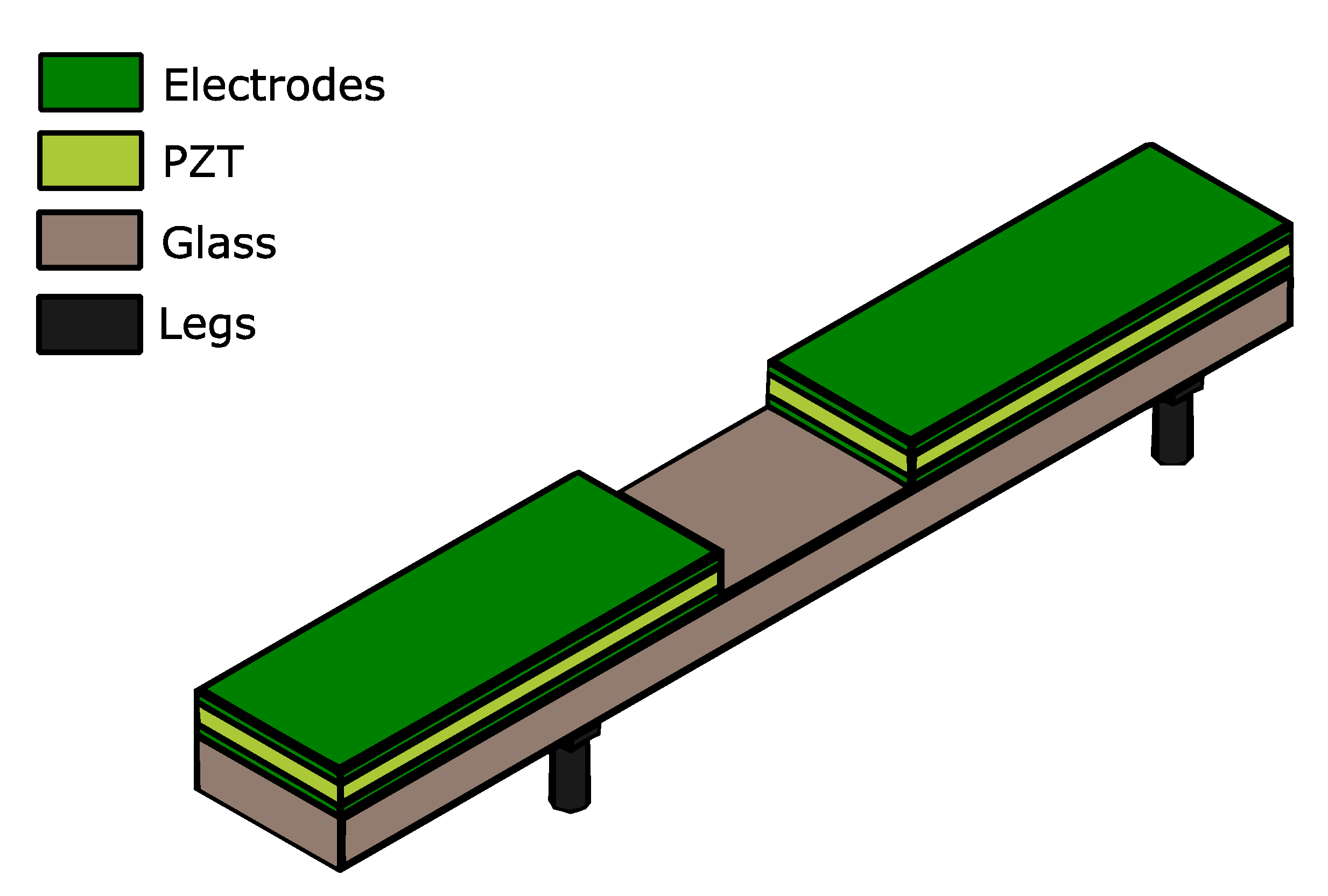
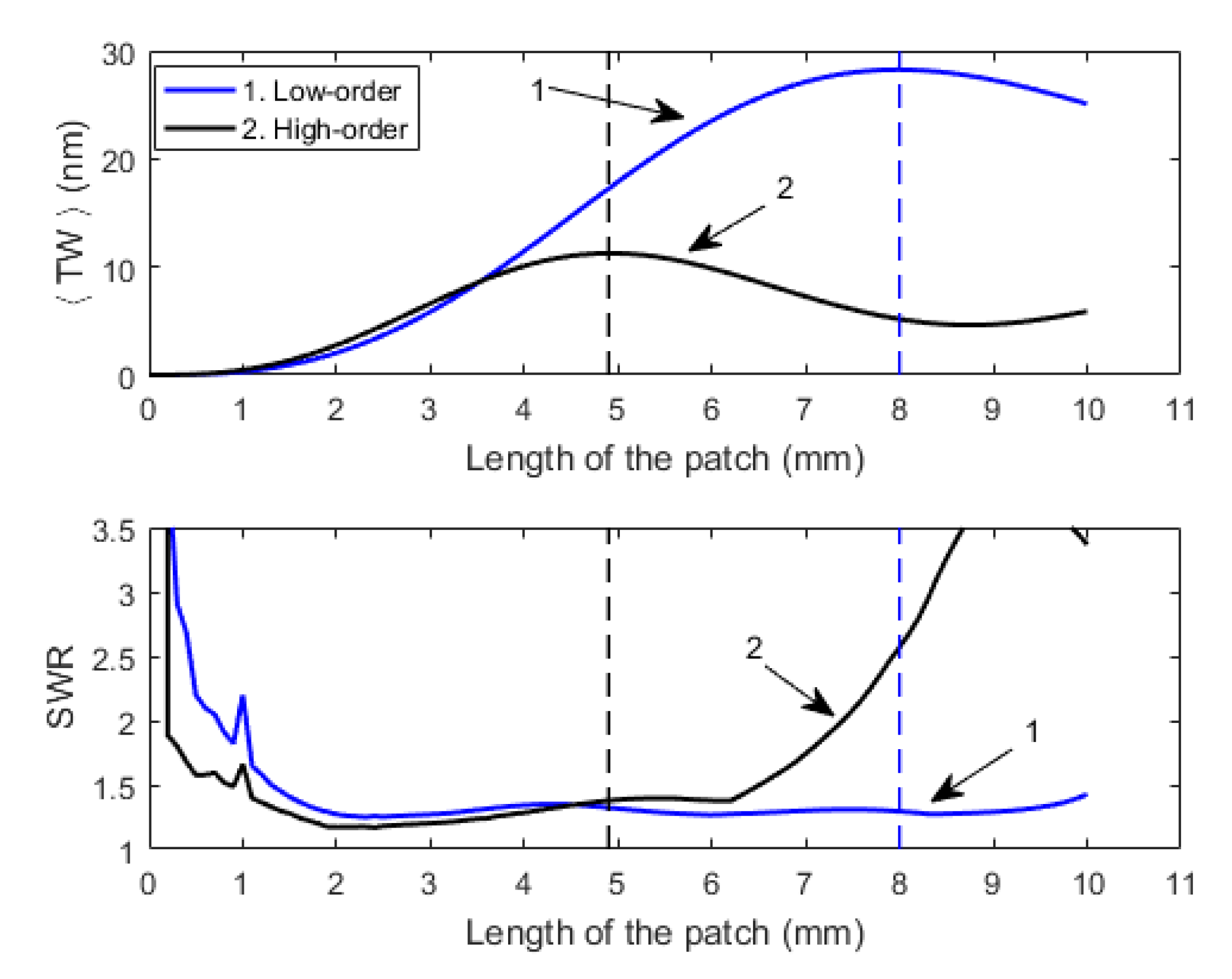
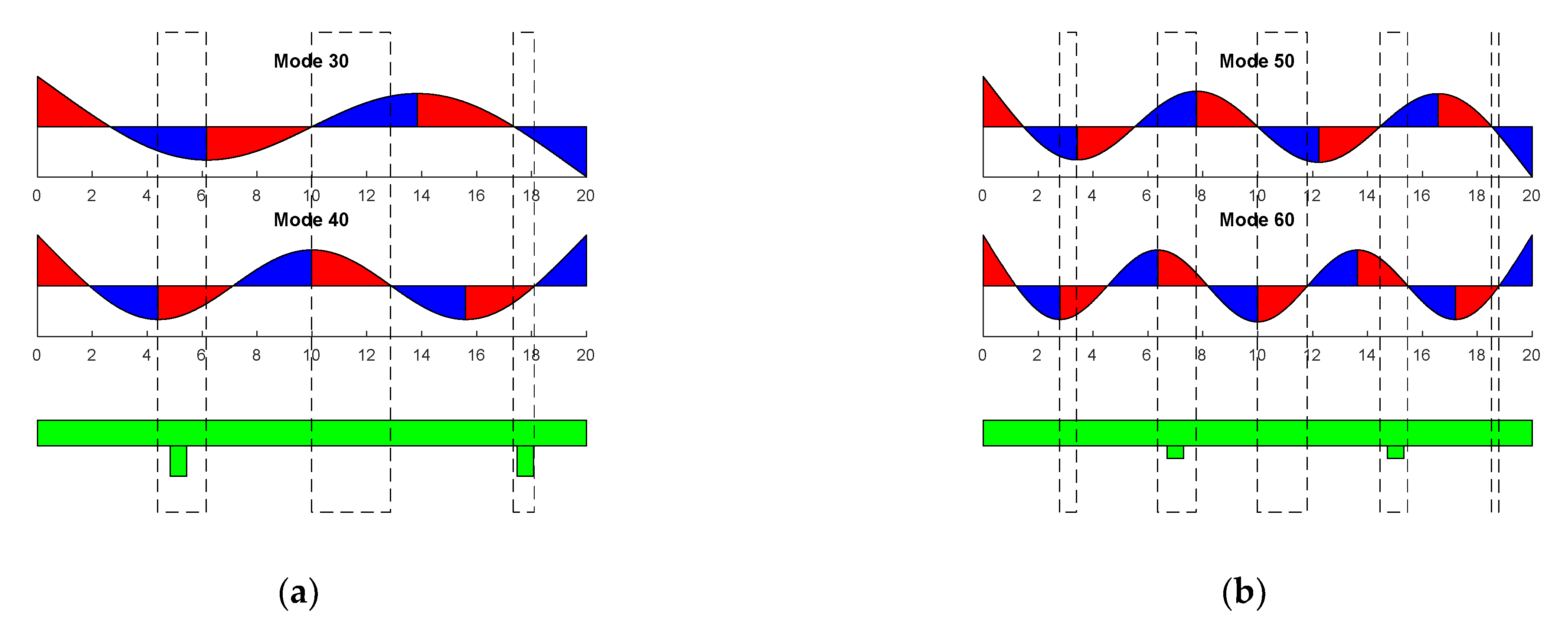
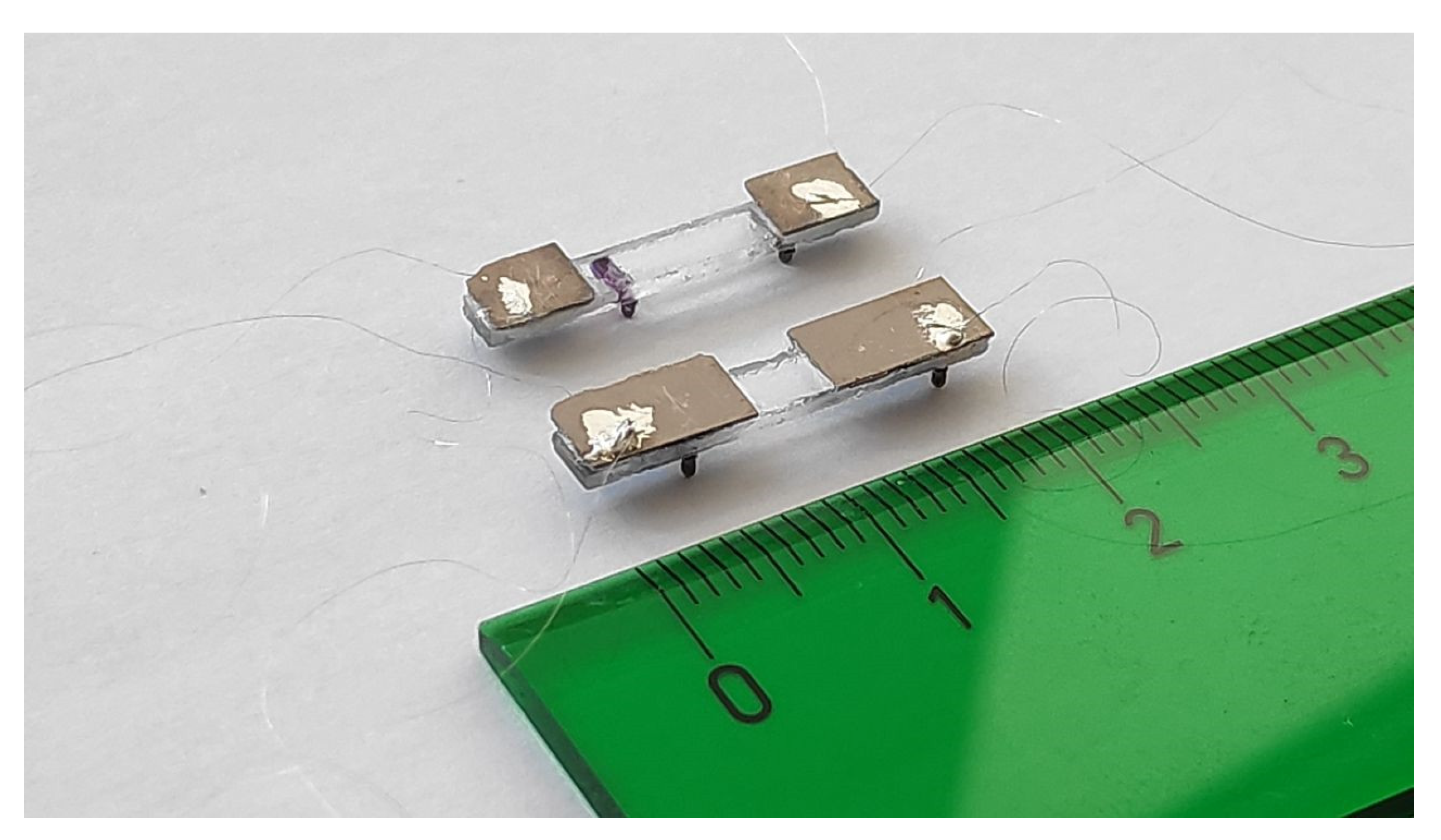
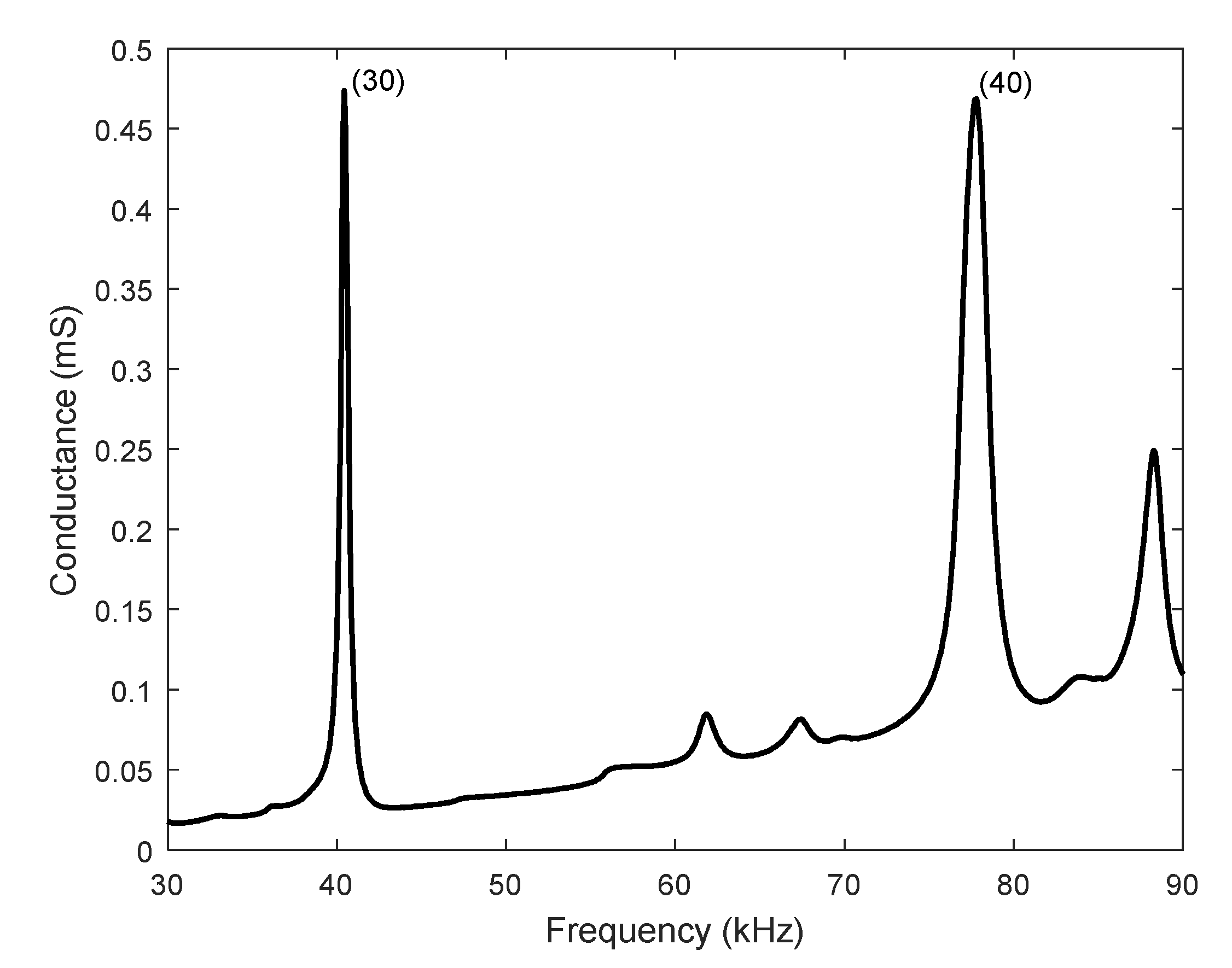
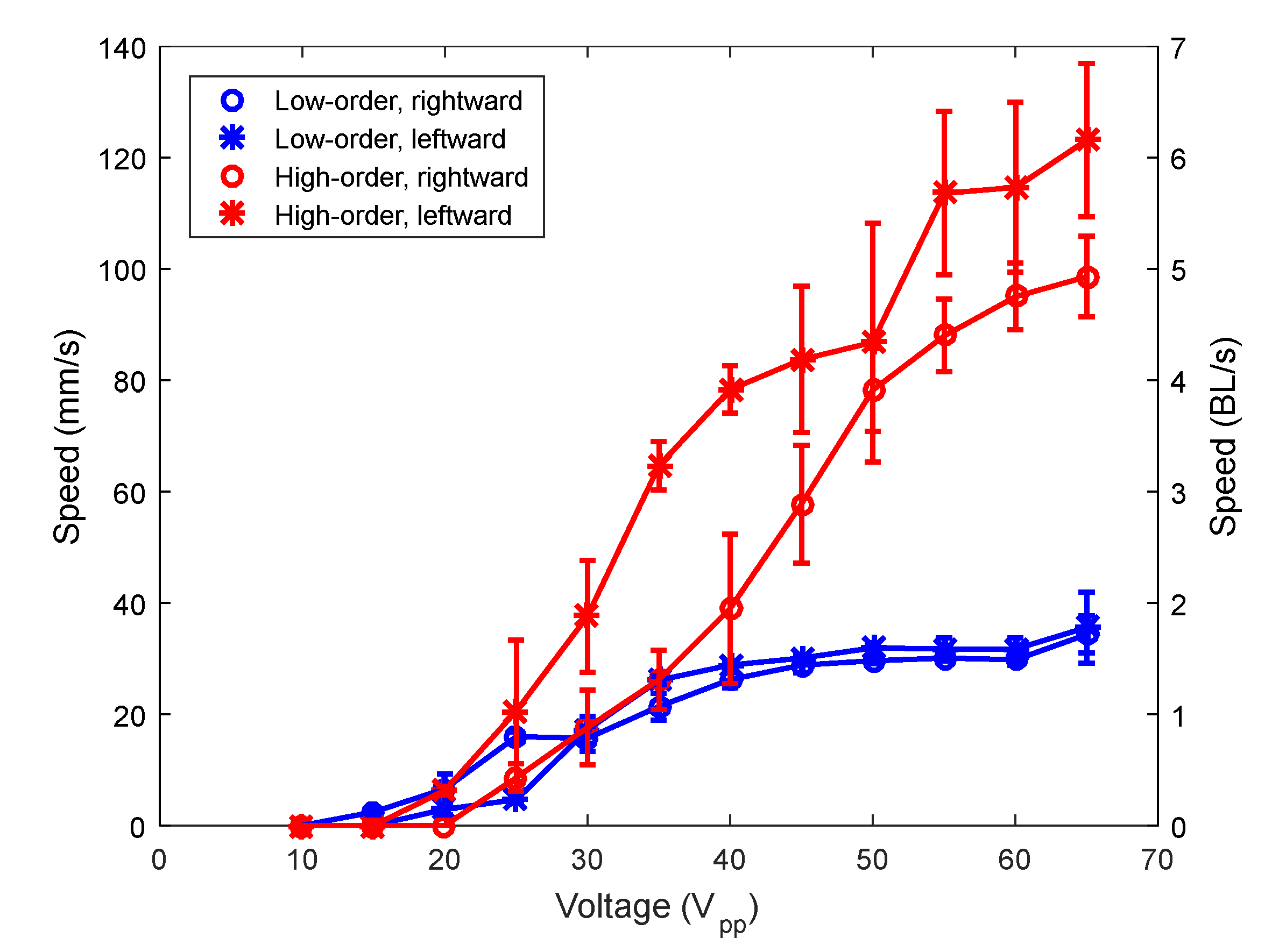
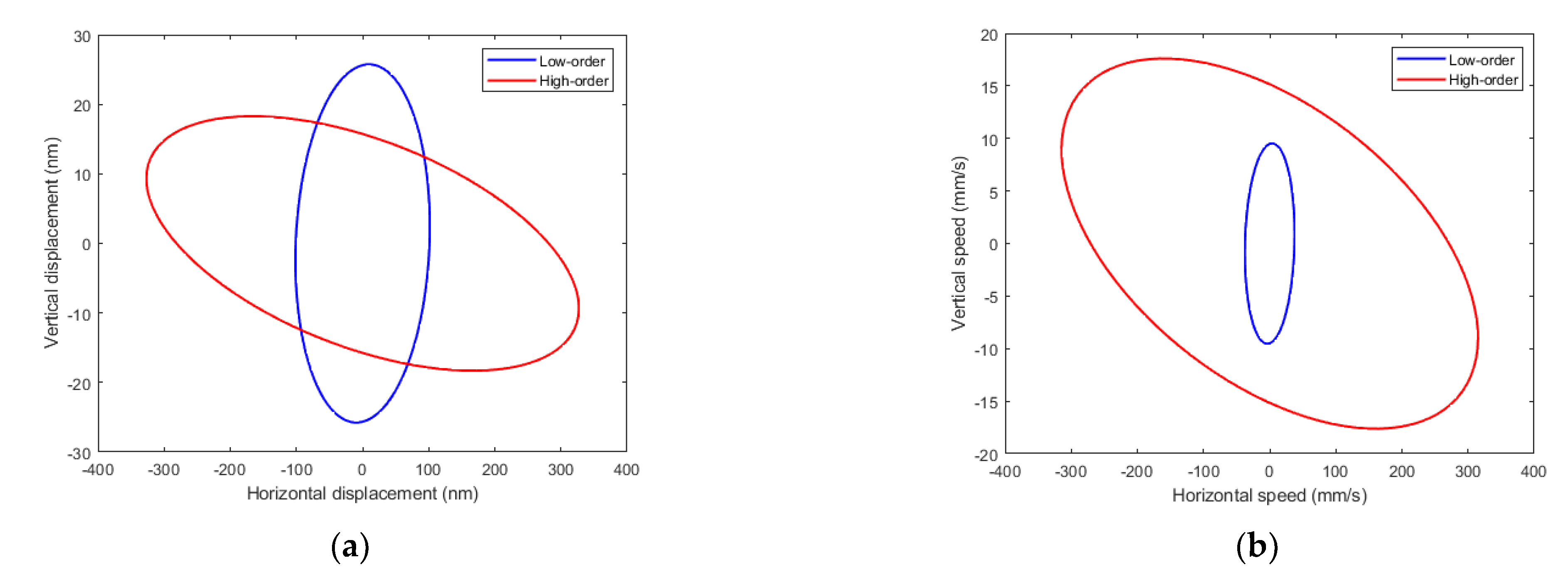

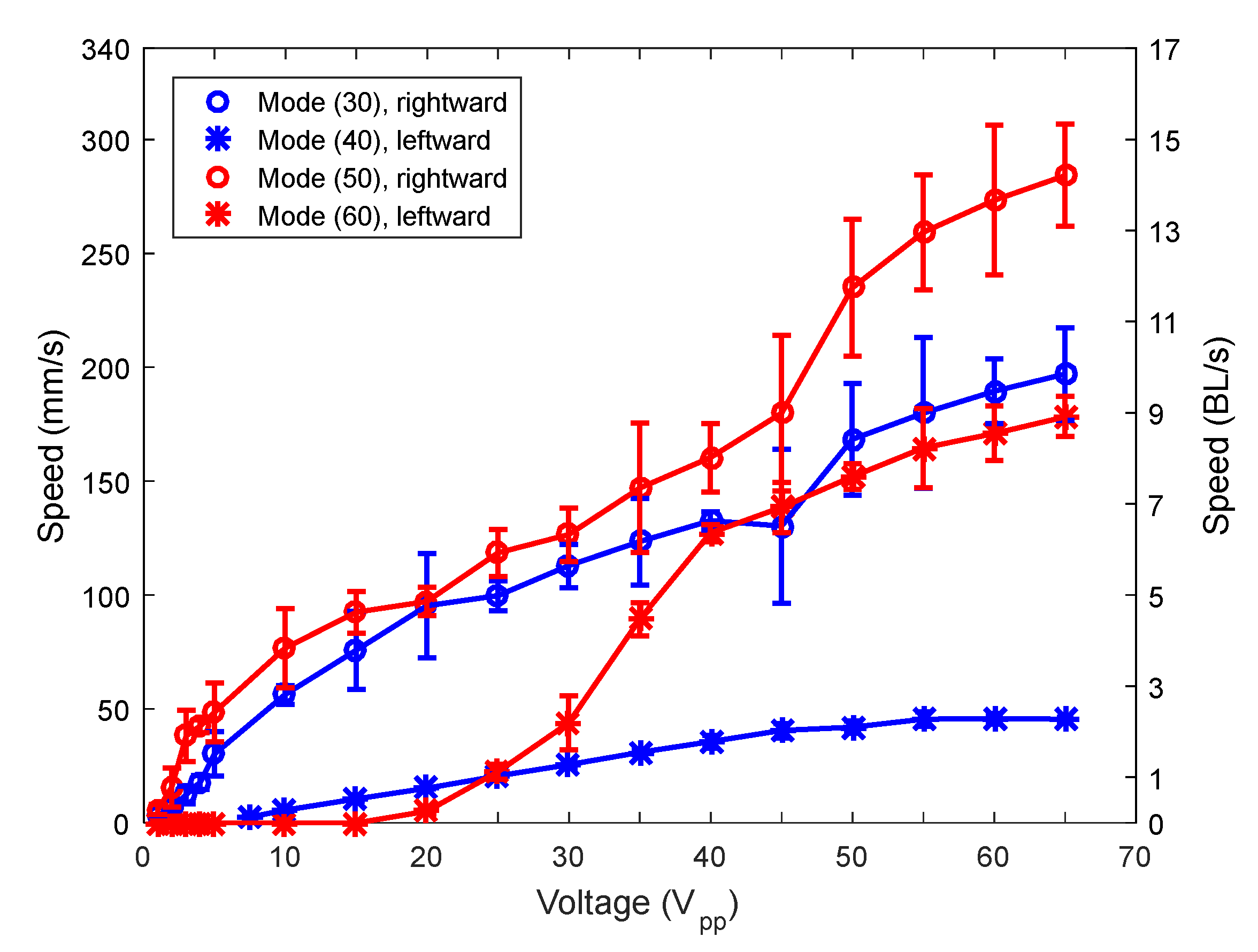
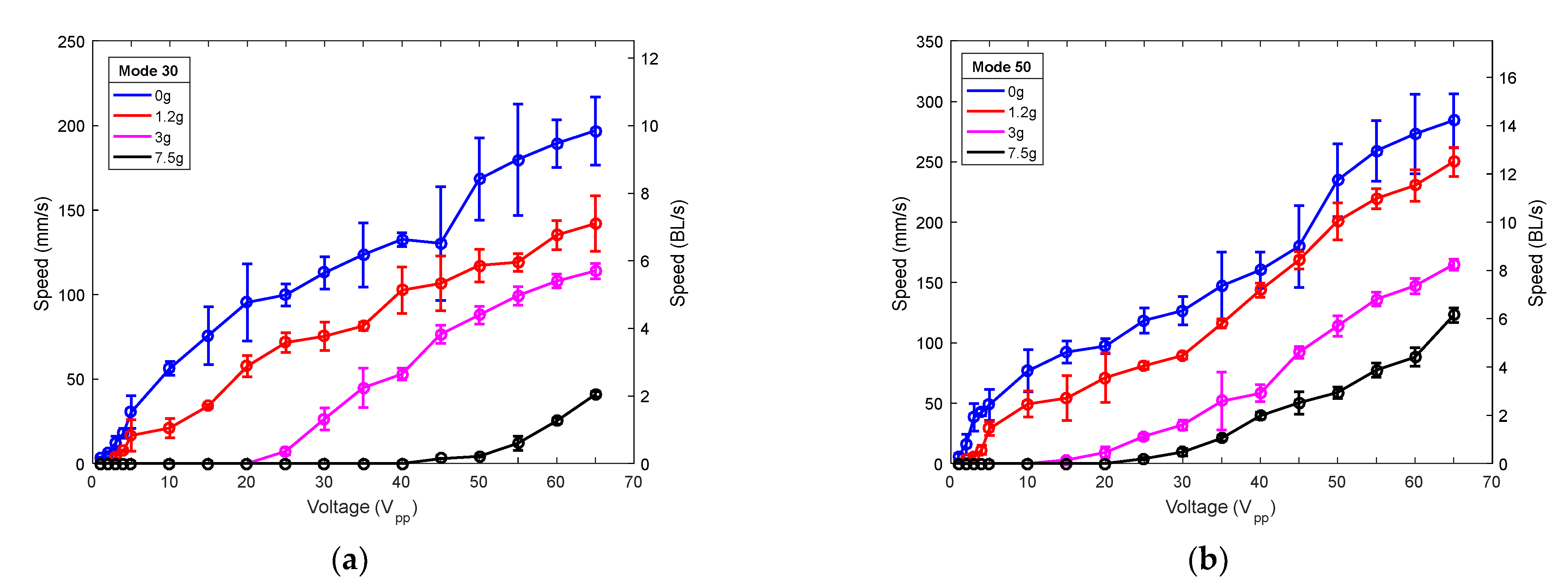
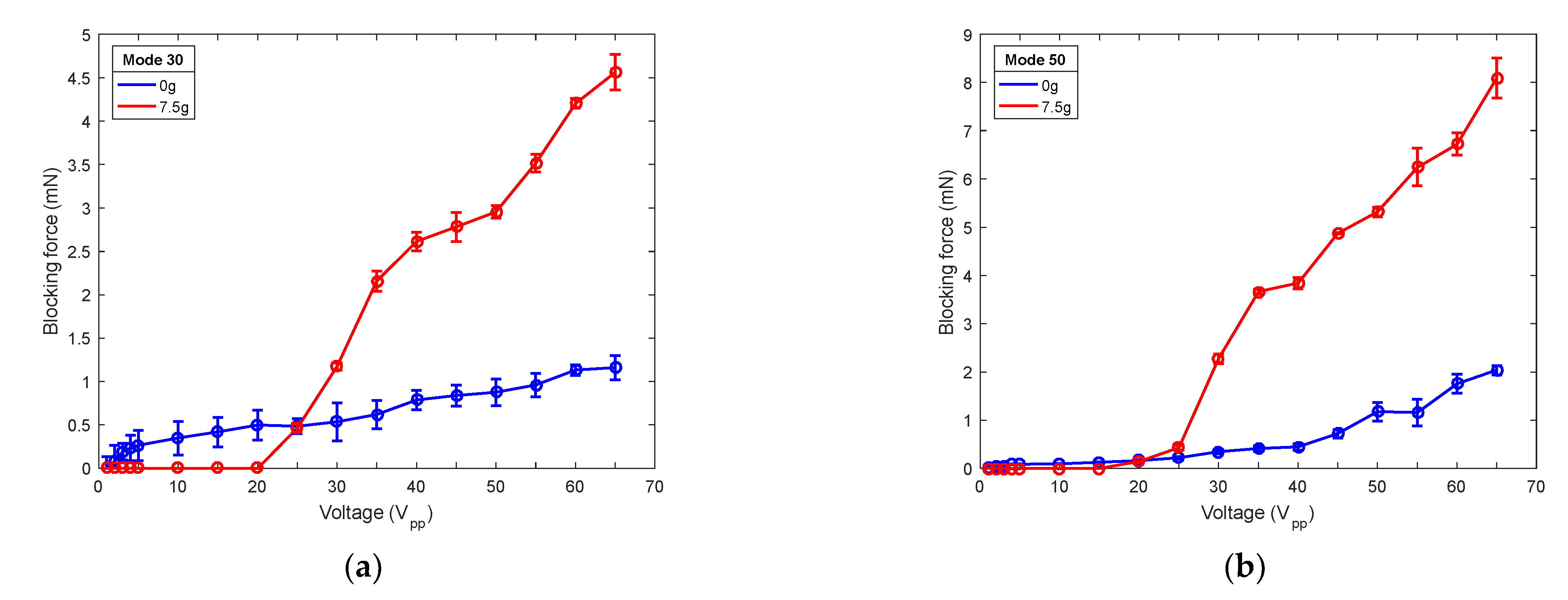
| Thickness (mm) | Young Modulus (GPa) | Density (kg/m3) | |
|---|---|---|---|
| Glass | 1 | 72.9 | 2653 |
| PZT | 0.2 | 62 | 6700 |
| Operation Mode | SW | TW |
|---|---|---|
| Patch length | Low-order combination: 8.0 mm High-order combination: 4.9 mm | |
| Driving frequency | (f1 + f2)/2 | Rightward: f1 Leftward: f2 |
| Phase difference | Leftward: 90° Rightward: −90° | Leftward: 0° Rightward: 180° |
Publisher’s Note: MDPI stays neutral with regard to jurisdictional claims in published maps and institutional affiliations. |
© 2021 by the authors. Licensee MDPI, Basel, Switzerland. This article is an open access article distributed under the terms and conditions of the Creative Commons Attribution (CC BY) license (http://creativecommons.org/licenses/by/4.0/).
Share and Cite
Hernando-García, J.; García-Caraballo, J.L.; Ruiz-Díez, V.; Sánchez-Rojas, J.L. Comparative Study of Traveling and Standing Wave-Based Locomotion of Legged Bidirectional Miniature Piezoelectric Robots. Micromachines 2021, 12, 171. https://doi.org/10.3390/mi12020171
Hernando-García J, García-Caraballo JL, Ruiz-Díez V, Sánchez-Rojas JL. Comparative Study of Traveling and Standing Wave-Based Locomotion of Legged Bidirectional Miniature Piezoelectric Robots. Micromachines. 2021; 12(2):171. https://doi.org/10.3390/mi12020171
Chicago/Turabian StyleHernando-García, Jorge, Jose Luis García-Caraballo, Víctor Ruiz-Díez, and Jose Luis Sánchez-Rojas. 2021. "Comparative Study of Traveling and Standing Wave-Based Locomotion of Legged Bidirectional Miniature Piezoelectric Robots" Micromachines 12, no. 2: 171. https://doi.org/10.3390/mi12020171





